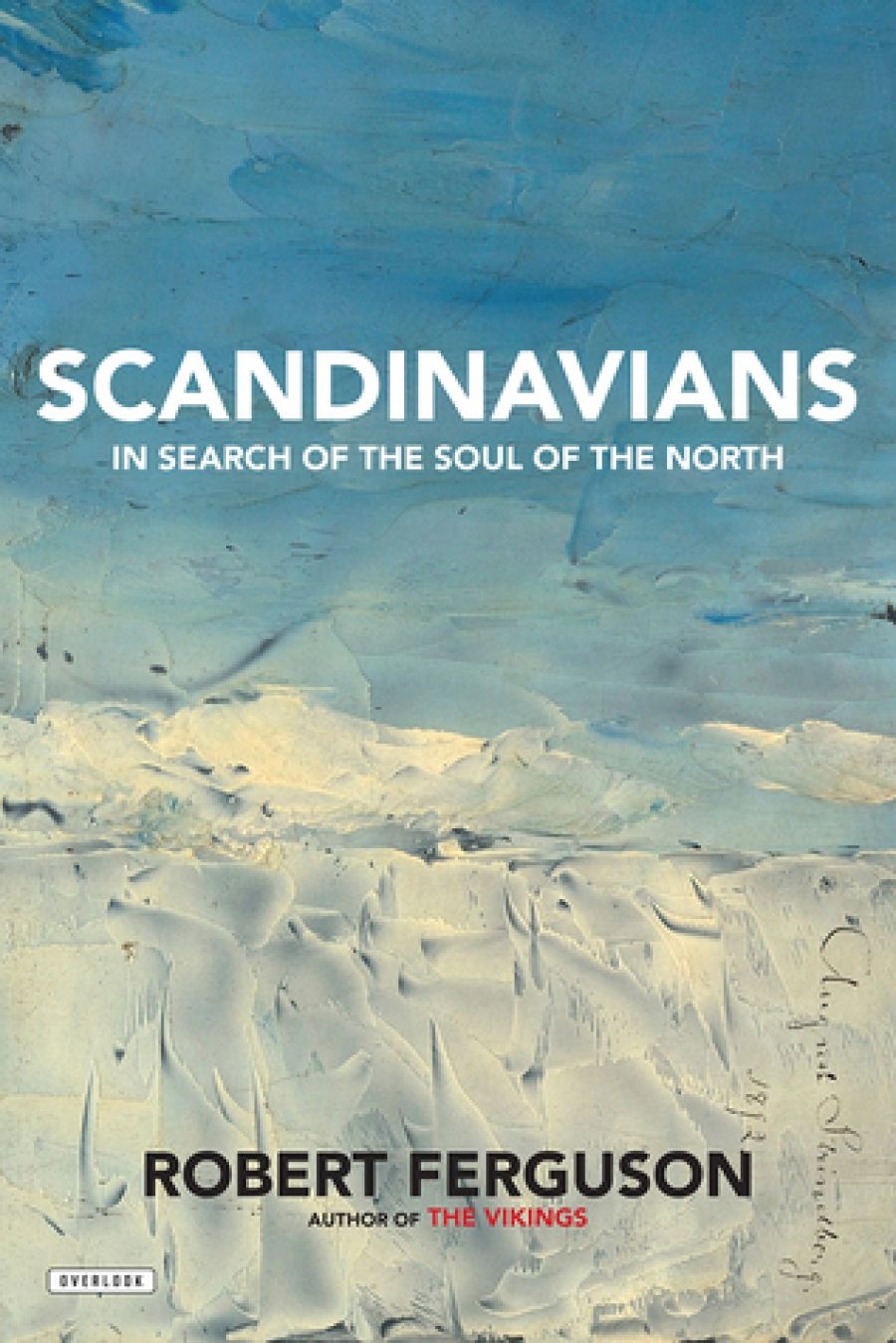
- Free Article: No
- Contents Category: Cultural Studies
- Custom Article Title: Kári Gíslason reviews 'Scandinavians: In search of the soul of the North' by Robert Ferguson
- Custom Highlight Text:
When I was twenty-seven, I visited mainland Scandinavia for the first time. I had spent the last of my travel money on a rail pass, and I was on a tight budget. One day, I thought I would save some money on accommodation by catching an overnight train from Stockholm to Trondheim. When I woke up the next morning ...
- Book 1 Title: Scandinavians
- Book 1 Subtitle: In search of the soul of the North
- Book 1 Biblio: Overlook Press, $35 hb, 480 pp, 9781468314823
Norway and Sweden, as indeed Denmark, the third country in Robert Ferguson’s cultural history of the region, have a great deal in common. They share stories from the Viking Age, centuries of joint rule and border conflict, and at times desperate poverty which in the nineteenth century saw many Scandinavians leave for the United States and Canada. All three countries now enjoy a reputation for egalitarian social structures and progressive cultural policies. Meanwhile, underneath it all there is supposedly a darker side, the melancholy and despair that we see in the films, television series, and crime novels of Nordic noir.
Robert Ferguson moved to Norway as a young man. For decades he has worked there as a translator, scriptwriter, and author. This book charmingly reflects a strong affection for the people and the region. While his ‘search for the soul of the north’ does, perhaps inevitably, feel centred in his adoptive hometown of Oslo, he moves fluently across borders, conscious of the differences that exist.
Like most neighbouring states, Norway, Sweden, and Denmark are often intensely competitive. In the fourteenth century, Denmark took a controlling hand in the formation of a common monarchy, while in the centuries since Norway and Sweden have established their own power and position in the region. In the 1600s, Denmark and Sweden raced to buy manuscript copies of the Icelandic sagas. In the nineteenth century, when Norway’s efforts to reach the North Pole began to take shape, the Swedes answered with a hydrogen balloon expedition.
One of the joys of Scandinavians is the manner in which Ferguson collects such historical moments. This is, in a sense, a book of examples. Their order is chronological, but there is little attempt to find trends or consistent underlying causes. The search for the soul of the North turns out, thankfully, to be pluralist in nature: we meet many versions of that soul, as shaped by different times and geographies, as by the particular moments in which they are recalled and discussed.
As a result, the Scandinavia of this book evolves as a diverse place. We learn about the ill-fated hydrogen balloon expedition, and also Viking and early Christian culture, Hamlet, the impact of the Reformation and the Enlightenment, and even the life and views of Søren Kierkegaard. In most of these studies, the cultural-historical moment is paired with one in the author’s life, from his travels and research through to a very touching account of his relationship with Erling Jonsrud, a friend whose alcoholism shadows the story of North Pole expedition and heightens its theme, self-destruction.
 Postcard of the station of Swedish explorer Salomon August Andrée, who attempted to travel to the North Pole with a hydrogen balloon. (Wikimedia Commons)
Postcard of the station of Swedish explorer Salomon August Andrée, who attempted to travel to the North Pole with a hydrogen balloon. (Wikimedia Commons)
Ferguson gives his friends and companions a prominent role in narrating the individual tales of the book. In one chapter, for example, he implores a poet he has met to put aside his work in order to finish telling him the story of the mad Danish King Christian VII and his doctor, Johann Friedrich Struensee, an Enlightenment figure who was the first to introduce total freedom of expression to Scandinavia. As elsewhere in this book, the conversation that follows allows the author to raise our popular perceptions of Scandinavia, while having them debated and undercut from a local perspective.
This device is especially useful when, towards the end of the book, Ferguson raises some of the most enduring conceptions of the North, such as the prominent social position of Scandinavian women, or the idea that all Scandinavians are born with a touch of melancholy. Of course, there is evidence for both things, but the book’s real contribution lies in the way it listens to Scandinavians, who assert a much more nuanced and specific view. If Ferguson brings the idea of a common Scandinavia together in this book, he is also happy to have it pulled apart again.
 Carta marina, a 1539 map of Scandinavia by Olaus Magnus (Plymouth Marine Laboratory, Wikimedia Commons)
Carta marina, a 1539 map of Scandinavia by Olaus Magnus (Plymouth Marine Laboratory, Wikimedia Commons)
That must at least partly be down to Ferguson’s delightfully literary and reflective style. He trusts details, and raises questions more often than he offers answers. In the middle of the book we are even given the entire script of a play. At first, I thought it was a long excerpt, but it is in fact Ferguson’s own work, an imagining of a moment late in Henrik Ibsen’s life when the playwright was visited by Else Sofie Birkedalen, the mother of his illegitimate child. It is a bold and inventive moment in the book, and at first seems a little out of step with the rest. And yet it also suits the nature of this study, one that allows diverse and specific human exchanges to produce their own kind of unity. That is, not a firm answer to what the soul of Scandinavia might be, but a portrait of the pleasurable, individual moments of the search itself.


Comments powered by CComment